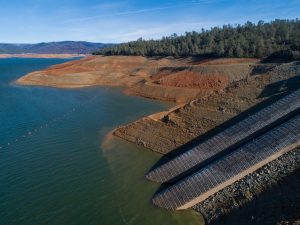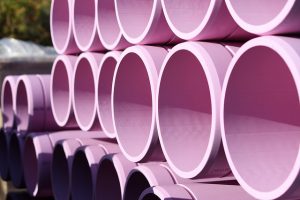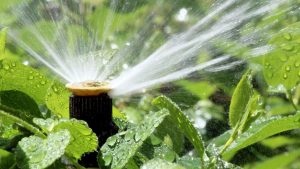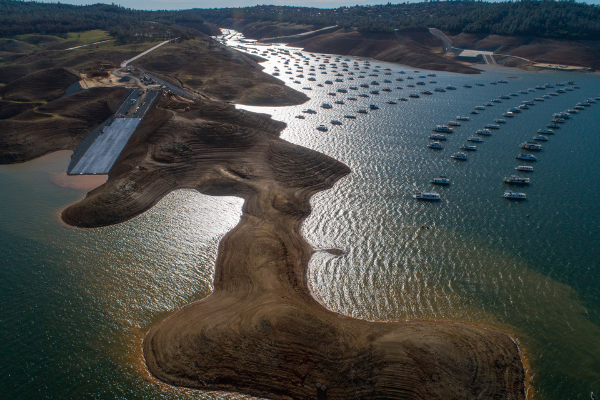The drought has returned to California. In just a few short weeks, the drought emergency declared by Governor Newsom in two Northern California counties has been broadened to include the Klamath River, Sacramento-San Joaquin Delta and Tulare Lake watershed counties — expanding to a total of 41 out of 58 counties.
The drought emergency declaration comes a mere five years after the end of the state’s longest, hottest stretch.Department of Water Resources Director Karla Nemeth recently commented on how thinking has shifted among water leaders: “It’s time that Californians plan to move away from drought emergencies and get to drought management.” In other words, recurring cycles of drought are commonplace not rare. California must work toward a resilient water supply tailored for warmer temperatures, more intense droughts and winters that bring more rain and less snow.
Newsom has launched efforts to respond to the latest drought emergencies. While the reemergence of drought conditions may not come as a surprise to many Californians, the state as a whole, and Southern California, specifically, is better prepared to handle this drought than ever before. The reason: collective long-term sustainability efforts underway for the past ten years.
However, the work is not done. While we can be sure that there will be a drought after this one, we cannot be sure that we will be prepared for it unless we act now. In order to build greater sustainability, many of the continuous efforts being built upon in our state are converging as part of the vision for meeting water supply challenges like droughts, earthquakes, and aging infrastructure through the Governor’s Water Resilience Portfolio.

A drone view shows the water level at Lake Oroville on February 4, 2021.
Andrew Innerarity / California Department of Water Resources.
Fortunately, the federal and state governments are funding water infrastructure like never before. These fiscal contributions help to support lasting sustainability projects, but they must be spent wisely across multiple efforts to build lasting water supply resilience in the face of future climate change impacts. A number of sustainability projects must be counted on to support the resiliency of California’s water supply. Through hard work and critical foresight, many of these projects are already underway.
We know from decades of experience that there is no one solution to regional water supply resilience. All solutions must be considered together in what we often call the “all-of-the-above” approach to water supply for the state — one that includes conservation, local supply development, storage, conveyance improvements, watershed management and groundwater management. We elaborate on a few key approaches below.
Delta Conveyance
The Delta Conveyance project, a key aspect of the Water Resilience Portfolio, seeks to modernize aging infrastructure to include a single-tunnel conveyance through the Delta that will correct the current system’s vulnerabilities. A Notice of Preparation of the Environmental Impact Report for the Delta Conveyance project was announced in 2020, which marked progress of project advancement, but it is critical to realize the project’s overall development. The Delta Conveyance is a linchpin to statewide resource reliability and environmental benefit. The modernization of this critical piece of the water management puzzle will prove to be a key feature in of our future resilience. Staying up-to-date on its developments and supporting each step in its progress will help to realize this infrastructure update in a timely manner.

Purple pipe is used to convey recycled water to irrigate landscapes and other purposes.
Water reuse
Recycled water is also key. Southern California leads the nation in recycled water efforts, regularly decreasing imported water usage. This is because the southern counties invest in water reuse treatment centers that perform state-of-the-art water treatment technologies to ensure that every drop of water we have, is used multiple times. Some water purveyors in Southern California, such as the city of Los Angeles and Santa Margarita Water District, have a goal of recycling 100% of their wastewater in the next ten years. With the introduction of wastewater treatment technologies and government funding, ambitions such as these are entirely attainable. Setting high targets for regional recycled water will contribute greatly to preparing for drought conditions.
Stormwater capture
Southern California is on track to lead the nation in harnessing the power of both its rainstorms and dry weather runoff through innovative stormwater capture projects. Large-scale projects include L.A. County’s Safe Clean Water Program. These projects aim to make the most any rain that does fall in Southern California by capturing, treating and storing it for reuse during dry times.

Using water efficiently outdoors is key to reducing our water consumption.
Reducing water waste
For Californians, reducing the amount of water we waste is key. In fact, the cheapest water is always the water not used. This is done through measures such as using low-flow showerheads and waterwise landscapes instead of thirsty lawns. Using water efficiently doesn’t have to mean sacrifice, as many in Southern California know. Since 1990, despite continuous population growth, Southern California manages to steadily decrease water use per person. Pinpointing these successes and implementing them statewide could prove to be beneficial. Governor Newsom has reported that the state has seen a 16% decrease in urban water usage since the conclusion of the last drought in 2016, relating it to Californians’ water use efficiency mind-set. Californians care about using water wisely, recycling and the environment more than ever. It’s a mindset that will help us cope with the impacts of climate change. After all, we are all in this together.
It’s our responsibility to prepare California for inevitable drier conditions to come. Water use efficiency management can be achieved through the compilation of multiple efforts to secure statewide water resiliency. This kind of portfolio investment makes us both resilient and affordable to meet future demands and customer needs. Collaboration in sustainability efforts will be key in ensuring that drought conditions do not cause a state of emergency.
